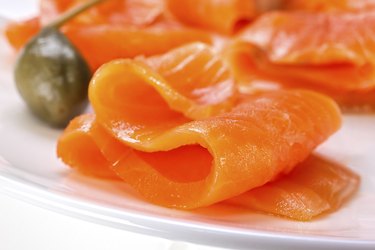
Start to Finish: 25 minutes, plus up to 5 days curing time Servings: 6 Difficulty: Intermediate
Bagels and lox are similar to the classic Jewish spread of bagels and cold smoked salmon. Lox however, is salt-and-sugar cured salmon slices, and, unlike cold or hot smoked salmon, is never smoked or cooked. Making your own lox at home, using this recipe inspired by one from The Kitchn, allows you to customize your salmon as a cost effective and enjoyable weekend project.
Video of the Day
Video of the Day
Ingredients
Lox 2 pounds fresh salmon filet, skin on 2/3 cup white sugar 3 tablespoons sea salt 1/2 cup fresh dill, chopped * 1/4 cup white drinking alcohol, such as vodka or gin (optional)
Bagels and Condiments 1/2 cup red onion, chopped 2 tablespoons capers, small to medium sized 12 tablespoons cream cheese, more to taste 1 lemon, cut into wedges 4 tablespoons fresh dill, minced Ground black pepper
Directions
Lox Pick out any remaining pin bones -- the small sharp bones -- from the salmon filet. Rinse the salmon under cold water and pat dry with paper towel.
Score the skin side of the salmon in large cross hatches, only gently exposing the flesh. Do not cut too deeply -- the filet should still be intact.
Rub both sides of the filet with the salt and sugar. Place the filet skin-side down on a large piece of plastic wrap. Sprinkle the exposed flesh with all of the fresh dill. Drizzle the tops of the filet with the alcohol, if desired, for a lighter flavor.
Wrap the salmon tightly in plastic wrap, ensuring there is no exposed meat and that little air can reach the salmon. Place in a shallow pan or large plate. Place a large plate on top of the filet, and weigh it down with a heavy can, such as a can of beans.
Refrigerate the salmon, with the plate and can on top, for at least 48 hours, and up to 5 days if desired. Drain the plate during this time as the juices from the fish leach out.
Rinse your fish under cold water until all of the salt, sugar, dill and exuded juices are removed. Pat the fish dry and wrap in plastic wrap until ready to use, storing in the fridge.
Serve the lox by slicing along the flesh side of the filet, angling your knife 45-degrees from the table. Do not include slices of the skin, and keep your slices as thin as possible. Serve immediately after slicing.
Bagels and Condiments Slice your bagels in half, lengthwise, producing two doughnut-shaped halves. Toast your bagels until they are lightly browned.
Spread roughly 1 tablespoon of cream cheese on each bagel half. Top each bagel half with minced onions and capers, if desired.
Place a single layer of lox over the onions and capers, and top with minced dill. If you like, squeeze some fresh lemon juice onto each bagel half and add ground black pepper to taste.
Tips
The thicker the filet of salmon is, the better the overall quality of your lox, as the cured meat retains more texture. Thicker filets take longer to cure, however. A 1-inch-thick filet should be ready in 48 hours. In some cases, if you use extra salt and sugar, it can be ready in 24 hours. However, a piece 2 inches thick or more could take the full 5 days to fully cure.
To test for doneness, cut off a small piece before rinsing and draining the salmon. Rinse it free of the marinade, and taste to test for flavor and saltiness. Lox is also a slightly darker color than uncured salmon and is a solid color throughout, so if the center for the filet is a different color, the filet may not be fully cured yet.
Lox is traditionally made from only the belly of the salmon, which produces a richer tasting product. However, any part of the salmon works to make lox.
Variations
Vary the spices and herbs used for marinating the lox to your taste. Brown sugar, honey or even stevia can be used in place of white sugar. Salts can be flavored, such as smoked sea salt, which adds further dimension to your lox.
For a fancier presentation, layer thin slices of beet on the flesh side of the salmon, over the chopped dill, before wrapping and marinating. This adds extra sweetness to your salmon and a delicate ruby color to the meat.
Adding lemon zest in place of minced herbs for the lox produces a brighter, lighter tasting lox.